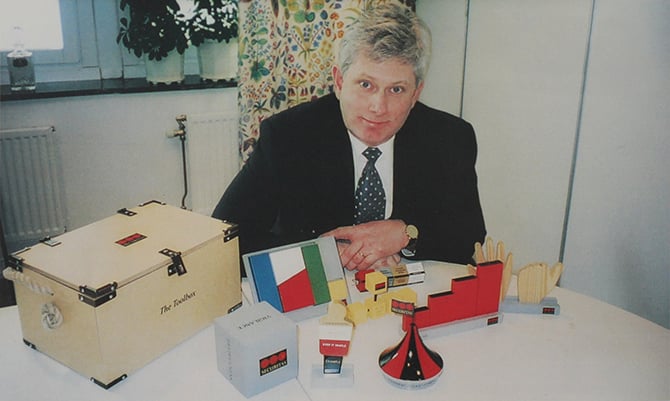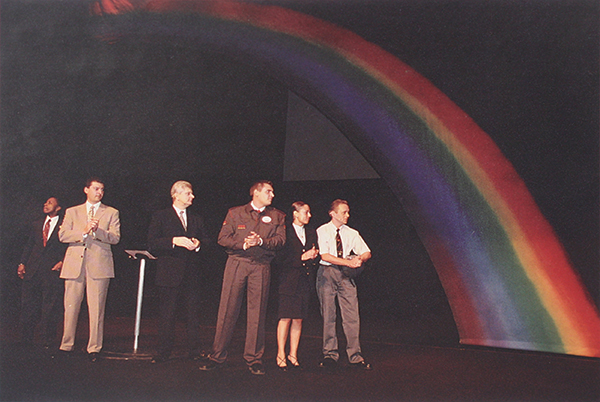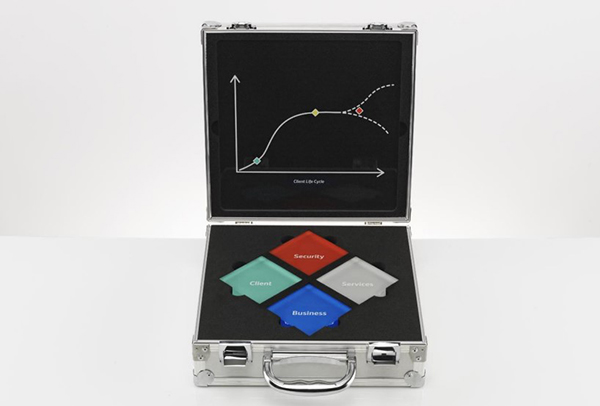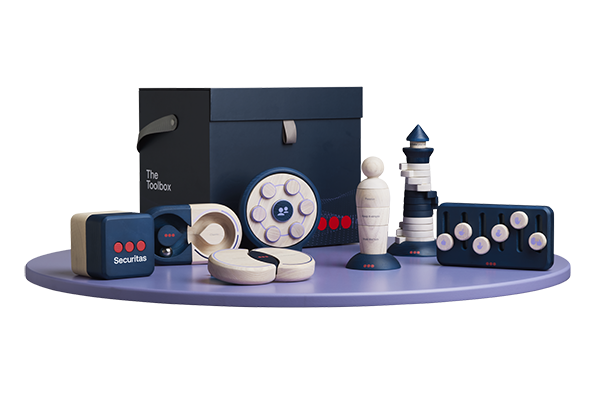A new reporting method
On a dark November evening at Securitas’ headquarters in 1987, CEO Melker Schörling and management team members Thomas Berglund and Håkan Winberg had just been presented with the month's results on paper. And it was a lot of paper! Thomas took the report home, spread it across the living room floor, and began analyzing the numbers by placing them within a broader context. Standing in a sea of paper, Thomas realized a new reporting method was needed. With 100 offices across Sweden, the growing business was in desperate need of a unified way to measure success.
Creation of the Five Fingers
The discussions led to the identification of five crucial areas upon which the company should measure performance. These included:
- New customer contract sales
- Net changes in the portfolio of customer contracts
- Total sales
- Gross margin
- Indirect expenses
These five areas were later named “Five Fingers”, a nod to the hand’s five fingers and a reminder that everybody always has at hand. Focusing on these key measurement areas provided managers with a clearer understanding of their business results, helping to improve operations and enhance client relationships.
To spread these five new principles throughout the organization, a unique communication method was employed. All managers received a special package alongside the monthly report, with the recipient's name elegantly written in golden letters. This personalized package emphasized the importance of each individual and their role in shaping the future of the company. Managers were also asked to explain the significance of each “finger” to their teams in person.
In 1989, the Five Fingers became Six Fingers after Securitas made its first acquisitions outside of Scandinavia, necessitating a measurement for the number of outstanding accounts receivable days. Different countries and cultures have varying payment practices in terms of invoice due dates. When expanding geographically, ensuring timely payments became increasingly important.
The Six Fingers is still today one of the seven tools in the Securitas Toolbox. Each tool represents a fundamental principle, and together, they capture identity, approach to work, and interactions with clients and the world. In short, they encapsulate Securitas’ DNA.
Developing the tools
After a common framework for reporting was established, the next item on the agenda was to redefine Securitas' approach to client relationships, leading to the creation of the Market Matrix. This initiative began with a series of brainstorming sessions. For visualization purposes, large physical blocks were used to illustrate ideas and concepts. However, the tools used were never used outside the workshop, but merely as visual aids on paper or showed using overhead projectors (an ancient device projecting images or text printed on transparent sheets onto a screen or wall).
Fast forward 15 years. Securitas was growing significantly and had gained a larger global presence, requiring more effective management training. But without a deeper understanding of Securitas' cultural and operational ethos, it was difficult to achieve the desired progress. To organize thoughts and visualize ideas, Anette Venneman from the Communications Department went to a local hardware store and bought a toolbox to keep the conceptual blocks. The tools and the toolbox from the store sparked an idea. Since principles of management training were often referred to as “tools”, why not let the management tools materialize into physical tools?
Said and done. Each management principle was transformed into a wooden tool, housed within a crafted wooden toolbox. This approach allowed managers to physically interact with each tool, enhancing their engagement with the core principles and facilitating the effective implementation of the tools.

Thomas Berglund behind the original Securitas Toolbox from Management Bulletin No. 2, May 2000
The toolbox evolves above and beyond
When the toolbox was introduced, Thomas reflected on Securitas’ progress: "Once we defined our focus, established our structure, and secured our team's commitment, we started seeing improved results. We approached expansion methodically – first in Sweden, then across Europe, and by 1999, we had moved into the Americas. We had our strategy pieces in place but needed a way to effectively communicate our philosophy.”
Thomas, known for his knack for demystifying complex issues, emphasized the Toolbox's simplicity. It had to be easily understood by branch managers who operated the business. And the physical toolbox, crafted from simple wooden materials, reflected this simplicity.
To construct anything in life, Thomas said, be it a house, a boat or a company, you need tools. Different companies require distinct sets of tools. With Securitas Toolbox all teams had the best tools available to construct a world-leading security firm.
The grand unveiling of the Toolbox took place in Barcelona under the banner of "Everything you have to know to become a security leader in the world”. It was a major event, where a giant Toolbox emerged from the ceiling during the unravelling.

At the Securitas Toolbox launch at the Securitas International Meeting in Barcelona in the year 2000
When the event was over, security personnel at the airport were given a heads-up that 1 000 people, each lugging a hefty 6-kilogram wooden box, would be passing through the airport corridors. Despite the early warning, thousand managers with big toolboxes caused a small chaos at the airport... Setting the confusion aside, this moment at Barcelona’s airport marked a milestone in Securitas' journey towards building a unified, culture-driven global workforce.
![]()
Outside-in perspective and the diamond box
By 2011, Securitas had entered a new era of growth. In a hectic two-year period from 2009 to 2011, 49 acquisitions were completed. During this time, Gisela Lindstrand, the Senior Vice President of Corporate Communications and Public Affairs, played a crucial role. Her mission was clear and simple: to bring the Securitas identity to the acquired companies worldwide and to initiate the integration and alignment of operations and culture.
For a long period, the Toolbox provided a robust framework for operations and management but as time went by it no longer accurately reflected the strategic development of the business, using terminology and concepts from business areas that no longer existed. It also became apparent that it did not sufficiently reflect a client-first perspective. While the Toolbox continued to play an important role, a new tool was created – the Diamond Box – focusing on putting client needs at the center throughout the client lifecycle. The Diamond Box, initially developed by Santiago Galaz, President of Securitas North America, and Bart Adam, President of Security Services Europe, included important tools, especially for commercialization. However, using two toolboxes became confusing; and as the business continued to develop there was a need for a new combined toolbox.

The Diamond Box - prioritizing client needs throughout every stage of the client lifecycle
When Magnus Ahlqvist became President and CEO of Securitas in 2018, he already understood and experienced the strength of the Toolbox from his years as divisional President for Europe. His grasp of the Toolbox’s potential and importance led him to make its reassessment one of his initial priorities. Magnus undertook a thorough review together with CFO Bart Adam, and CHRO and CMO Helena Andreas. Respecting the fundamental concepts of Securitas’ DNA, the review determined which elements needed updating and which could remain as is. For a year and a half, several assessments were conducted, including comprehensive surveys to take the pulse of the entire organization, and seven truly global and cross-functional working groups provided comprehensive input into each updated tool which was then summarized to fully capture Securitas’ DNA.
An ever-evolving Toolbox
The transformation of the Securitas toolbox successfully integrated digital enhancements while preserving its physical components. This evolution from a strictly physical set of tools to a hybrid model includes an interactive 3-D version and a digital platform with videos and text. These updates improved accessibility, engagement, and utility across Securitas’s global operations, blending traditional and modern methods to meet diverse needs.
To stay true to its purpose of making the world a safer place, Securitas always needs to adapt to modern times, and so does the Toolbox. Echoing Thomas Berglund's insights from two decades ago: constant evolution remains crucial. As Securitas pushes further into digitalization and technology, the Toolbox continues to play a key role in this journey, ensuring the company can confidently and clearly meet the challenges of today and tomorrow.
An investment in its people
Starting a new job and absorbing a vast amount of information about one's role and the industry can be overwhelming, but taking a Toolbox training helps things start to make sense. The Toolbox distils complex concepts into clear directions, serving as a guiding light in daily tasks and aligning with Securitas’ vision. A shared culture, way of working and language is essential to be able to serve clients consistently all around the world. The Securitas Toolbox encompasses history and experience and help us shape the future.

The Securitas Toolbox. From left to right: the Foundation, the Loop, the Multiplier, the Wheel, You Make the Difference, the Lighthouse and Six Fingers







